My List
8 favourites found.Helianthemum Pink (Pink Rock Rose)
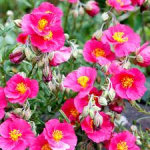 Sold Out
Sold Out
Helianthemum, commonly called Rock Rose, is a low growing shrubby perennial with woody dark green-grey foliage, pink flowers with yellow centre. Ideal for rockery in a sunny spot. Found in the North Atlantic region, mainly in dry grassy and rocky places across large parts of Europe.
Flowering: Summer [November - February]
Fruiting:
My Lists: Drought Tolerant
Helianthemum White (White Rock Rose)
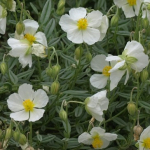
Helianthemum, commonly called Rock Rose, is a low growing shrubby perennial with woody greenish grey foliage, comes in white flowers with yellow centres. Ideal for rockery in a sunny spot. Found in the North Atlantic region, mainly in dry grassy and rocky places across large parts of Europe.
Flowering: Summer [November - February]
Fruiting:
My Lists: Drought Tolerant
Lavandula angustifolia (English Lavender)
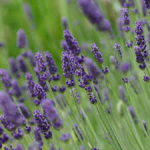 Sold Out
Sold Out
Lavandula angustifolia, commonly called English Lavender, is a sun loving perennial herb plant with mid to late spring bloom time. It is known as a xerophyte which by definition is a plant that has adapted to living in dry climate conditions. Poor soils are not a problem and are in fact preferred over rich moist ones. This makes Lavender perfect for sun drenched planting locations such as a hot dry bank that can be a real landscape problem area and can still withstand cold conditions during fall and winter. Evergreen. Hardy.
Excellent for crafts and dried flowers as they retain their color.
English Lavender (Lavandula angustifolia), also called True Lavender or Common Lavender is a type of lavender often associated with the famous purple lavender fields of Provence. Despite its common name, it is not native to England, but to the Mediterranean and counts over 40 different cultivars with flower spikes varying from blue-purple, lavender, violet-blue to white-pink.
Flowering: Spring - Summer [November - March]
Fruiting:
My Lists: Drought Tolerant
Lavandula dentata (French Lavender)
 Sold Out
Sold Out
Lavandula dentata, also known as French Lavender, is most often grown in pots or tubs, to be wintered indoors in all but very mild winter regions. Plants form a bushy shrub of grey-green, finely-toothed fragrant leaves, bearing short spikes of lavender-mauve flowers in midsummer. Easily pruned to keep a compact size. Choose a location with excellent drainage. In regions with clay soils, a raised bed or rock garden will improve success greatly. Attractive to butterflies.
Dentata flower year round but are less prolific during a hot, dry summer. They need a severe pruning at least once a year to maintain shape and prevent them from going woody - best time for a hard prune is October.
Flowering: Summer - Autumn [December - May]
Fruiting:
My Lists: Drought Tolerant
Lavandula stoechas (Spanish Lavender)
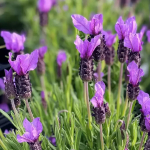 Sold Out
Sold Out
Lavender stoechas, is distinguished from other lavenders by its unusual flower blossoms. The flowers are typically purple, although they can also be pink or white, and are topped with distinctive “rabbit ears” or bracts that resemble wings.
Stoechas is used ornamentally in the garden and the flowers may be used to make Lavender sachets, Lavender wreaths and other dried floral arrangements. The flowers of Lavandula stoechas may be dried and used just like any others in the species.
Spanish lavender is native to the Mediterranean region and is a perfect fit for a Mediterranean-style garden. Combine it with other Mediterranean plants like rosemary, thyme, and sage for a garden that is both beautiful and functional.
Flowering: Spring [September - December]
Fruiting:
My Lists: Drought Tolerant
Rosmarinus prostratus (Creeping Rosemary)
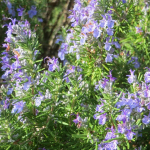
Rosmarinus prostratus, Prostrate Rosemary, or Creeping Rosemary, is a low-spreading, evergreen shrub or groundcover. Its leaves are green, leathery and very aromatic. This Creeping Rosemary has pale-blue flowers from early to mid-summer. Rosmarinus officinalis Prostratus can be used as a beautiful groundcover because of its height which reaches only up to 30cm and 150cm in its spread. Creeping Rosemary will trail over walls or edge of a raised bed to make a curtain like effect.
Culinary herb and many medicinal uses. This herb, especially the flower tops, contains antibacterial and antioxidant rosmarinic acid, plus several essential oils such as cineol, camphene, borneol, bornyl acetate, and α-pinene that are known to have anti-inflammatory, anti-fungal, and antiseptic properties. Many sources document rosemay’s effect on improving memory, slightly fewer mention its ability to attract lovers, and repel nightmares! Use woody stems as skewers on BBQ to impart flavour. Very drought tolerant. Full sun.
Flowering: Summer - Autumn [December - May]
Fruiting:
My Lists: Drought Tolerant
Rosmarinus Tuscan Blue (Upright Rosemary)
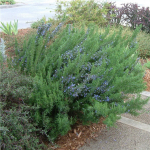
Rosmarinus Tuscan Blue is a large evergreen, upright Rosemary with a good flavor making it an excellent culinary herb, or a landscaping shrub. As an herb, Rosemary is used to flavor meat dishes, and condiments. The small blue flowers that appear in mid summer are edible as well, and make a nice garnish for salads. In the landscape Rosemary is used in hot, sunny locations as it is very drought resistant and withstands the heat and humidity well.
Many sources document rosemary’s effect on improving memory, slightly fewer mention its ability to attract lovers, and repel nightmares! A lovely children’s herb for this folklore reason but also due to its lingering scent, and its ability to take quite a battering from constant harvest for teas and ‘potions’.
The woody stems can also be used as skewers on the BBQ to impart flavour. Very drought tolerant. Full sun. Height to 2m.
Flowering: Spring - Summer [September - March]
Fruiting:
My Lists: Drought Tolerant
Santolina chamaecyparissus (Cotton Lavender)
 Sold Out
Sold Out
Santolina chamaecyparissus is commonly known as Cotton Lavender, this is a small shrub grown for its foliage and flowers. It produces a dense network of small and aromatic, grey-green leaves, cypress-like and acts as an insect repellent.. The foliage is adorned with mass of yellow, button-like flowers in summer. Flowers can be used in floral arrangements.
This evergreen grows with a rounded. It performs best when grown in full sun on a well-drained site, noting that is hardy to dry periods, coastal environments, and moderate frost once established. The Cotton Lavender is commonly included in borders, mass planted as a ground cover, maintained in a container, included in cottage or Mediterranean gardens, or planted around outdoor living areas. It is an easy plant to grow and very rewarding. A pretty cottage plant. Cut back after flowering.
Flowering: Summer [December - February]
Fruiting:
My Lists: Drought Tolerant
